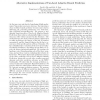34 search results - page 1 / 7 » A Comparison of Dynamic Branch Predictors that Use Two Level... |
ISCA
1993
IEEE
13 years 9 months ago
1993
IEEE
Recent attention to speculative execution as a mechanism for increasing performance of single instruction streams has demanded substantially better branch prediction than what has...
ISCA
1998
IEEE
13 years 9 months ago
1998
IEEE
Pipeline flushes due to branch mispredictions is one of the most serious problems facing the designer of a deeply pipelined, superscalar processor. Many branch predictors have bee...
ISCA
1998
IEEE
13 years 9 months ago
1998
IEEE
As the issue rate and depth of pipelining of high performance Superscalar processors increase, the importance of an excellent branch predictor becomes more vital to delivering the...
ISCA
1998
IEEE
13 years 9 months ago
1998
IEEE
Accurate branch prediction is essential for obtaining high performance in pipelined superscalar processors that execute instructions speculatively. Some of the best current predic...
EXPCS
2007
13 years 8 months ago
2007
Predictors are inherent components of state-of-the-art microprocessors. Branch predictors are discussed actively from diverse perspectives. Performance of a branch predictor large...


